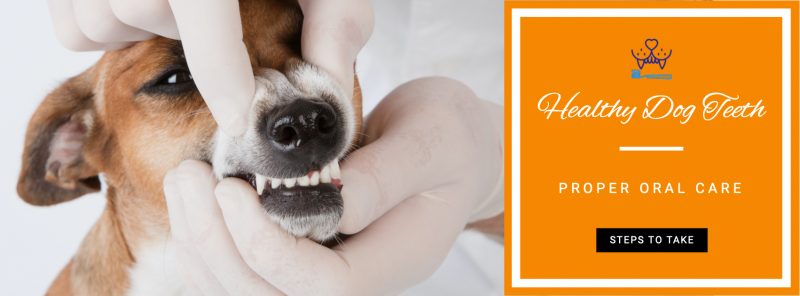As a loving pet owner, you do everything possible to keep your dog in tip-top shape, from feeding him the most nutritious food and treats to making sure he exercises daily and taking him to the veterinarian for preventative care. But are you paying enough attention to dog oral care? If not, it’s time to change your ways. After all, proper care is what makes the difference between healthy dog teeth and an oral condition that could be causing your pup discomfort (or even pain).
What Does a Healthy Mouth Look Like?
Before you learn how to take care of your dog’s teeth (and what can happen if you don’t), you need to understand what a healthy mouth looks like in the first place. Healthy dog teeth should be clean and free of plaque and tartar (hard, scaly or sticky discolorations). Similarly, your dog’s 42 teeth should be intact and not jagged or broken.
Your furry friend’s tongue should be moist — without any signs of lumps or cuts. And, in most cases, his gums should be salmon pink. Some dog breeds naturally have black or black-and-pink gums, which can making looking for the usual signs of discoloration tricky. Make sure you know what your pet’s mouth usually looks like, and talk to your vet if you spot any lumps, raised spots, pale gums or bright red tissue.
Brushing Your Pet’s Teeth
Dogs are born with healthy mouths, but they don’t automatically stay that way into adulthood — it’s up to us to help them keep their pearly whites in tip-top shape. Regular brushing with a dog-specific toothbrush and toothpaste helps, and so do certain toys and treats that are formulated to reduce bacteria in your pet’s mouth. Just as you brush your own teeth a few times a day, a dog’s mouth also needs daily attention. It can slow the buildup of plaque and tartar and lengthen the interval between professional dental cleanings.
If brushing your dog’s teeth is new to the both of you, be sure to take baby steps. You’ll want to get your dog comfortable with you touching his mouth and teeth first before you come at him with a toothbrush and toothpaste. First, touch his muzzle and practice rubbing your finger along his teeth and gums. Once he can handle this — while staying calm and relaxed — introduce the toothbrush. Let him smell it, and very gently rub it on his teeth. At first, just wet it with water, then add toothpaste later. This process may take a few days for each step. Go slowly, and don’t rush your pet. After all, you don’t want him to develop anxious or negative feelings about this routine.
Once you’ve developed the trust needed for successful brushing, it’s time to work on technique. First, lift your dog’s lips and brush his front teeth. Slowly work your way to the back of his mouth, paying careful attention to the outside of his teeth. You may need to pull back at first and only do a few teeth at a time. Once you’re both used to the process, you’ll find the routine quick and simple to complete. Dog toothpaste is also specially formulated to be as tasty as possible, as long as you like turkey and chicken better than minty freshness. Look for a dog-specific paste at your local pet supply store or vet’s office. Remember: You should never use human toothpaste on your dog, since the ingredients can irritate his stomach and make him extremely sick.
Other Home Care Options
If brushing does not work for you or your dog, there are other options. You can try wipes, or a variety of dental chew treats designed to slow the accumulation of tartar. Look for the seal of the Veterinary Oral Health Council (VOHC). That indicates that the product has been tested and has shown that it is effective.
For other ongoing dog oral care efforts, you can look into diets formulated to reduce tartar buildup. Dog food that is formulated for your dog’s oral care will help reduce plaque and tartar buildup as well as help to freshen his breath. For any dog parent that gets doggy kisses, fresh breath is a must!
Professional Dental Cleanings
Another important part of dog oral care is an annual professional cleaning at your vet’s office every one to three years. This procedure should be done under anesthesia. Anesthesia is necessary to do a complete dental cleaning, above and below the gum line and in other hard-to-reach places in ways that prevent oral and systemic diseases. The American Animal Hospital Association and the American Veterinary Dental College do NOT recommend anesthesia-free dentistry.
During this process your veterinarian may also want to take X-rays of your pup’s teeth to make sure there aren’t any other underlying issues, similar to what you might do at your own dental checkup. Half of dental disease is under the gum line. Dental x-rays often reveal problems that would otherwise be missed.
During the cleaning, all tartar and plaque will be removed from the teeth, and the teeth surfaces will be polished to slow future accumulation. Any problems that are found will be addressed and remedied.
By helping your dog maintain proper oral care, you can hopefully avoid minor and major oral conditions. Show your pet you care, and help him keep those teeth, gums and tongue clean.
